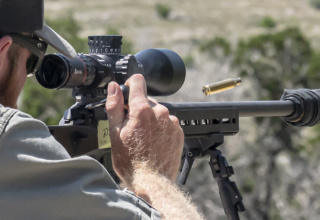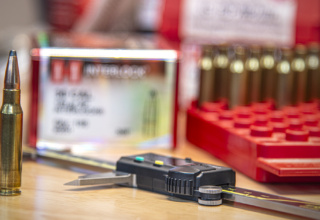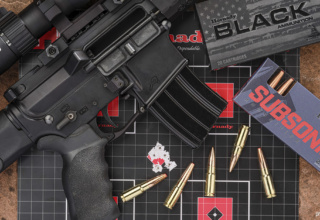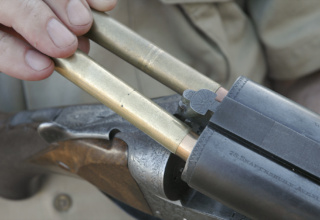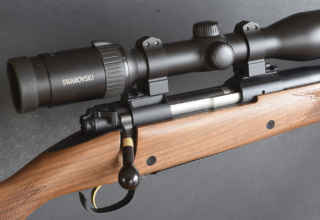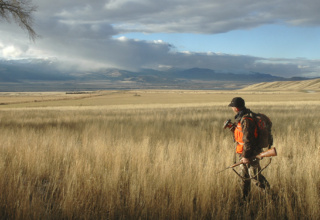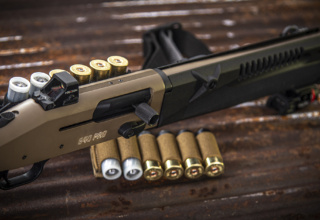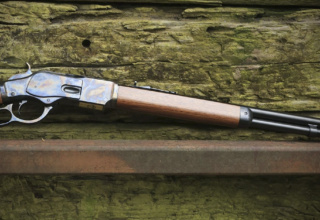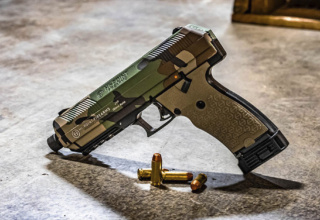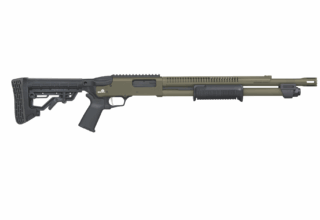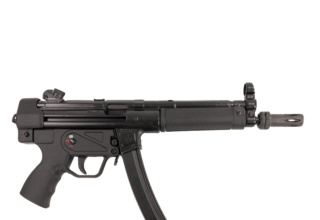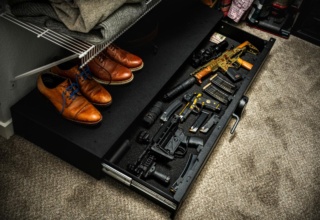Sleek and accurate, with a tip that defies drag, The Hornady ELD-X is a long-range wonder. But how does it hunt?
by Wayne van Zwoll
Wading an icy stream, we wound through Scotland’s thick, wet ferns and bellied to the crest of a ridge, where I crawled ahead and squinted into the Atlantic storm. The beast was still there, its vitals still shielded by broom that would turn my bullet. Lizard-low, soaked to the skin, I waited. When at last the stag turned, my sling came instantly taut against the Sauer 404. Horizontal rain pelted the Leica’s lens as the crosswire settled for a quartering shot to the off-shoulder. The .300 Winchester coughed into the blow, sending a 200-grain ELD-X bullet 90 yards. The great animal collapsed, dead.
It was my first dance with the ELD-X afield. I’d met it months earlier and far away. The fog lifted slowly that Nebraska morning, just west of Hornady’s sprawling Grand Island plant. Ghostly white dots emerged over the rye, rank upon rank.

“The smiley-face steel is 1,000 yards off, plates to the left 1,200,” said Ryan Damman. “Don’t shoot anything closer than 600. Too easy.”

Ready and silent beside me: a shiny Doppler unit. Imagine a broad ice chest lid made of porcelain. Its sending unit was on top, over the receiver. Like laser range-finders, Doppler radar determines an object’s position from the bounce of a beam, or waves. High-frequency microwaves reflected from a speeding bullet show what’s called a Doppler shift in frequency. The instrument reads hundreds of data points per shot. These come in a blink, showing data on velocity, time elapsed, and distance traveled.
Hornady’s team had found something else in the data: unexpected changes in ballistic coefficient.
“We had access to military Doppler in 2011,” said Dave Emary, then Hornady’s senior ballistician. “We bought our own unit in 2014. It registers bullet location at intervals of less than 2 feet during flight. The graph we got for the drag component showed bumps.”
Those small bumps persisted across brands of polymer-tipped bullets.

“We suspected changes in BC due to tip melt,” said team member Joe Thielen. “Time in flight, plus the friction induced by sustained speeds near Mach 3, hike tip temperatures to over 800 degrees. A melting tip loses its aerodynamic form. Air turbulence there increases drag, destabilizes the bullet. Result: steeper arcs, diminished accuracy. To shorten the tale, we pursued a poly tip that wouldn’t melt during flight. Our Heat Shield Tip trumps nylon and Delrin tips, with a glass transition temperature (at which polymer turns rubbery) of 475 degrees F. That’s eight times higher than the competitors’!”
The HST’s melt temperature of 700 degrees is twice as high as that of other tip materials.

“Tips of very fast bullets can exceed that 700-degree mark over 1,000 yards,” Emary pointed out. “But no bullet gets that hot quickly or stays that hot for long. Melt occurs when bullets with BCs of about .550 and above are driven at magnum speeds and fly for at least half a second. It doesn’t show on Doppler for 300 yards or so. Any melt on an HST tip will be brief, distortion insignificant.”
From accurate rifles, the new bullet proved their equal, pounding distant plates that day in 2014.
“In manufacture, neither hollowpoint nor open-tip match bullets finish up exactly the same at the nose,” said Thielen. “Each HST is identical to the next. We get measurably less vertical dispersion on targets.”
Unlike its sibling ELD Match, the ELD-X (for Extra Low Drag, Expanding) is designed to upset and penetrate in game. In gelatin tests at 150-yard speeds, wide temporal cavities extended 2 to 11 inches in 23-inch channels, tapering to bullet diameter at 18 inches. At 800-yard speeds, cavities were slimmer, behind straight-line penetration to 24 inches. Afield, the bullet quickly downed more than 70 big animals.

“Poly-tip bullets aren’t just hollowpoints with a cap,” Quinlan explained. “We design bullets like the ELD-X with tip and cavity as integral features to deliver the desired rate and extent of expansion. The HST initiates upset. It’s a bit bigger than most tips to ensure upset at impact velocities down to 1,600 fps. An Interlock pinch on the ELD-X shank helps maintain bullet integrity at strike speeds to 2,900 fps.”
Last fall, two animals shot with 143-grain ELD-Xs from rifles in 6.5 PRC left me wondering if the bullet drives deep enough in elk-size animals at modest ranges. A bull I hit, well but not perfectly, ran far enough to delay recovery. He fell in stride 140 yards on — after dashing through beaver ponds in the thick willow bottom, leaving no trail. An exit wound might have helped, though in all fairness, I don’t demand it of any bullet. An expanded bullet that bulges the off-side hide delivers all its energy.

The other animal, a mule deer, dropped instantly to a lung shot. A local butcher split it neatly, as he would a beef carcass. I was surprised to see no bullet mark on the far-side ribs.
Quinlan told me that while the ELD-X expands and penetrates more reliably than a hollowpoint, “long, tapered ogives and small noses aren’t compatible with the thick bullet jackets that yield deep, fist-size holes and 90-percent weight retention with up-close hits on tough animals. Instead, with ELD-X, you get flatter flight, higher-retained speed and energy at distance, and increased range at which the bullet will open dependably. You can expect better accuracy, too. Concentricity is harder to maintain on the heavy jackets that limit upset in bullets for brutes in the alders.”

The ELD-X is, by any measure, a lethal hunting bullet ballistically superior to most and with a long roster of first-shot kills to its credit. The elk that kept its feet? Some might argue a 143-grain bullet leans to the light side for elk, that a 162-grain 7mm or 200-grain .308 ELD-X are better options. But in truth, my hit could have been better — a reminder that any bullet can only deliver the results we deserve! Under most ground and cover conditions, I’d have recovered even this animal quickly.
Hornady loads ELD-X bullets with temperature-insensitive, single-base powders in ammunition it calls Precision Hunter, from .243 to .338 Lapua. A 175-grain 7mm ELD-X is available for handloaders.
Ballistic Coefficient is Not a Constant!
“Ballistic coefficient is a widely used term but often misunderstood,” says Jayden Quinlan. “It’s a way to compare drag of bullets similar in form to a standard projectile. The G1 standard resembles a 19th-century artillery projectile, with a steep 2-caliber ogive and flat base. The G7 better matches modern hunting and target bullets, with its long nose, 10-caliber ogive, and tapered heel.”
The higher its BC, the better any bullet battles drag.

“But BC isn’t static,” explains Quinlan. “It changes with the bullet’s deceleration. At high speed, a long, tapered ogive is more effective in limiting drag than a tapered heel. Below about 1,600 fps, heel taper becomes more important.”
Arguably, neither feature offers discernible benefit inside 200 yards, where most game is killed.



